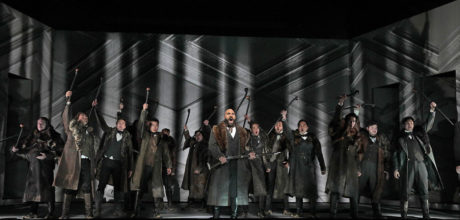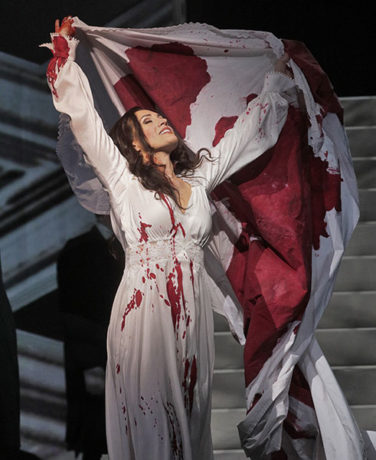Editor’s note: Our Steve Cohen continues his posts on the arts scene in Santa Fe, New Mexico, with a look at Santa Fe Opera’s production of Donizetti’s Lucia di Lammermoor.

Lucia di Lammermoor, the second opera I attended during my four night visit to Santa Fe, had several notable aspects, plus direct connections with Philadelphia.
But first, I can’t avoid the elephant in the room. Almost everywhere I go in this city, when strangers see that I’m from out of town they say, “Are you here for the Steve Jobs opera?” or “You must see the Steve Jobs opera.” Mind you, these comments come from non-musicians.
My 19-year-old nephew lives in Albuquerque and has no interest in opera yet told me that he and his friends wanted to get tickets but none were available. The opera company added an extra performance, which also sold out, and says it’s the most popular attraction in years.
Considering all of this buzz, please stand by for my report on The (R)evolution of Steve Jobs tomorrow.
Lucia, you will recall, is about a woman forced to break off from her beloved Edgardo and marry a man she hates, Arturo, because an alliance with him will help Lucia’s family’s fortunes.

Brenda Rae has a lovely lyric voice that also has flexible coloratura plus unusually strong projection. Her Lucia is no wilting violet. She dominates the stage throughout the opera. With a combination of good looks, a lovely sound, and dazzling technique, Rae jumps to the top among all of todays’s Lucias.
In the mad scene, after she stabs to death her bridegroom on their wedding night, Lucia’s hallucinations were accompanied by a glass harmonica as written by Donizetti, rather than by the commonly-used flute. The instrument is a series of glass goblets containing differing amounts of water, thus giving them different pitches, and they’re played by the performer vibrating his or her fingers around the rims of the glasses. The instrument supposedly was invented by Benjamin Franklin, so there’s another Philly connection.
I much prefer the glass harmonica over the flute for this aria. It projects a softer sound, an eerie tone that matches Lucia’s state of mind. Bravo to Maestro Corrado Rovaris for choosing it, and to Friedrich Heinrich Kern for playing it, virtually unseen, in the pit. (This instrumentation can be heard on a recording with Beverly Sills, conducted by Julius Rudel.)
During most of the rest of the opera, Rovaris chose tempi that went from pleasingly lilting to exaggeratingly galloping. It was a very fast musical narrative.
The rather hammy acting, as directed by Ron Daniels, was disappointing except for Rae’s work. Tenor Mario Chang as Lucia’s true love Edgardo; baritone Zachary Nelson as Lucia’s brother Enrico; tenor Carlos Santelli as the unfortunate groom Arturo; and Christian Van Horn as the chaplain Raimondo each had some fine moments but there were many inconsistencies.
The chorus, under the direction of Susanne Sheston, was excellent, but it was a letdown to see them all face the audience during the mad scene instead of interacting as if commiserating with each other and saying to each other, “how awful!”
The scenic design by Riccardo Hernandez was unremarkable, lacking the originality of concept that Santa Fe Opera is known for. Costumes by Emily Rebholz and lighting by Christopher Akerlind were fine.
Running Time: Two hours and 55 minutes, including one intermission.
Lucia di Lammermoor had its final performance on August 26, 2017 at Santa Fe Opera, performing at the Opera House – 301 Opera Drive, in Santa Fe, New Mexico. Tickets to next year’s festival can be purchased online.




